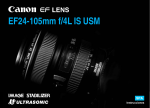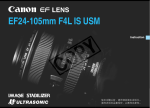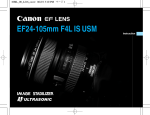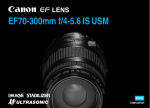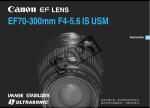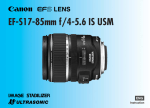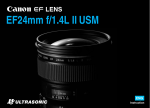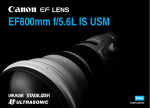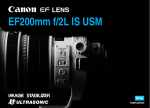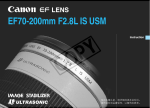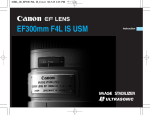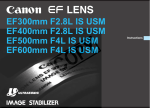Download Canon 0344B002 Camera Lens User Manual
Transcript
EF24-105mm f/4L IS USM C Y P O ENG Instruction Thank you for purchasing a Canon product. The Canon EF24-105mm f/4L IS USM lens is a high-performance standard zoom lens developed for EOS cameras. It is equipped with an Image Stabilizer, and covers a wide range of focal lengths from wide angle to mid-telephoto. ¡“IS” stands for Image Stabilizer. ¡“USM” stands for Ultrasonic Motor. C Conventions used in this instruction Warning to prevent lens or camera malfunction or damage. Features 1. The Image Stabilizer gives the equivalent effect of a shutter speed three stops faster.* 2. Aspheric and super UD lens elements for excellent imaging performance. 3. Ultrasonic motor (USM) for quick and quiet autofocusing. 4. Manual focusing is available after the subject comes into focus in autofocus mode (ONE SHOT AF). 5. A truly round aperture hole results in a nicer background blur. 6. Tight seal structure ensures excellent dustproof and drip-proof performance. Y P O * Based on [1/focal length] second. Generally, it requires a shutter speed [1/focal length] second or faster to prevent camera shake. Supplementary notes on using the lens and taking pictures. ENG-1 a Safety Precautions a Safety Precautions • Do not look at the sun or a bright light source through the lens or camera. Doing so could result in loss of vision. Looking at the sun directly through the lens is especially hazardous. • Whether it is attached to the camera or not, do not leave the lens under the sun without the lens cap attached. This is to prevent the lens from concentrating the sun’s rays, which could cause a fire. Handling Cautions C • If the lens is taken from a cold environment into a warm one, condensation may develop on the lens surface and internal parts. To prevent condensation in this case, first put the lens into an airtight plastic bag before taking it from a cold to warm environment. Then take out the lens after it has warmed gradually. Do the same when taking the lens from a warm environment into a cold one. • Do not leave the lens in excessive heat such as in a car in direct sunlight. High temperatures can cause the lens to malfunction. This device complies with Part 15 of the FCC Rules. Operation is subject to the following two conditions: (1) This device may not cause harmful interference, and (2) this device must accept any interference received, including interference that may cause undesired operation. Do not make any changes or modifications to the equipment unless otherwise specified in the instructions. If such changes or modifications should be made, you could be required to stop operation of the equipment. This equipment has been tested and found to comply with the limits for a class B digital device, pursuant to part 15 of the FCC Rules. These limits are designed to provide reasonable protection against harmful interference in a residential installation. This equipment generates, uses and can radiate radio frequency energy and, if not installed and used in accordance with the instructions, may cause harmful interference to radio communications. However, there is no guarantee that interference will not occur in a particular installation. If this equipment does cause harmful interference to radio or television reception, which can be determined by turning the equipment off and on, the user is encouraged to try to correct the interference by one or more of the following measures: • Reorient or relocate the receiving antenna. • Increase the separation between the equipment and receiver. • Consult the dealer or an experienced radio/TV technician for help. Y P O This Class B digital apparatus complies with Canadian ICES-003. ENG-2 Nomenclature Focus mode switch (→ 5) Distance scale (→ 8) Infrared index (→ 8) Hood mount (→ 9) Zoom ring (→ 5) Filter mounting thread (→ 10) C Y P O Zoom position index (→ 5) Focusing ring (→ 5) Contacts (→ 4) Image stabilizer switch (→ 6) Lens mount index (→ 4) For detailed information, reference page numbers are provided in parentheses (→ **). ENG-3 1. Mounting and Detaching the Lens See your camera’s instructions for details on mounting and detaching the lens. ¡After detaching the lens, place the lens with the rear end up to prevent the lens surface and electrical contacts from getting scratched. ¡If the contacts get soiled, scratched, or have fingerprints on them, corrosion or faulty connections can result. The camera and lens may not operate properly. ¡If the contacts get soiled or have fingerprints on them, clean them with a soft cloth. ¡If you remove the lens, cover it with the dust cap. To attach it properly, align the lens mount index and the K index of the dust cap as shown in the diagram, and turn clockwise. To remove it, reverse the order. C The lens mount has a rubber ring for enhanced water- and dust-resistance. The rubber ring may cause slight abrasions around the camera's lens mount, but this will not cause any problems. If the rubber ring becomes worn, it is replaceable by a Canon Service Center at cost. Y P O ENG-4 2. Setting the Focus Mode 3. Zooming To shoot in autofocus (AF) mode, set the focus mode switch to AF. To use only manual focusing (MF), set the focus mode switch to MF, and focus by turning the focusing ring. The focusing ring always works, regardless of the focus mode. C To zoom, turn the lens’ zoom ring. Y P O Be sure to finish zooming before focusing. Changing the zoom ring after focusing can affect the focus. After autofocusing in ONE SHOT AF mode, focus manually by pressing the shutter button halfway and turning the focusing ring. (Full-time manual focus) ENG-5 4. Image Stabilizer You can use the image stabilizer in AF or MF mode. the STABILIZER 1 Set switch to . ¡If you are not going to use the image stabilizer function, set the switch to . Y P O you press the 2 When shutter button halfway, the Image Stabilizer will start operating. C ¡Make sure the image in the viewfinder is stable, then press the shutter button the rest of the way down to take the picture. The image stabilizer in this lens is effective for hand-held shots under the following conditions. ¡In semi-darkened areas such as indoors or outdoors at night. ¡In locations where flash photography is prohibited, such as art museums and theater stages. ¡In situations where your footing is uncertain. ¡In situations where fast shutter settings cannot be used. ENG-6 Image Stabilizer ¡The Image Stabilizer cannot compensate for a blurred shot caused by a subject that moved. ¡Set the STABILIZER switch to when you are taking pictures using the Bulb setting (long exposures). If the STABILIZER switch is set to , the image stabilizer function may introduce errors. ¡The Image Stabilizer might not be fully effective in the following cases: • You move the camera for a panned shot. • You shoot while riding on a bumpy road. ¡The Image Stabilizer consumes more power than normal shooting, so fewer shots can be taken if you use the function. ¡The image stabilizer operates for about two seconds even when your finger is off the shutter button. Do not remove the lens while the stabilizer is in operation. This will cause a malfunction. C ¡With the EOS-1V/HS, 3, 30/33/Elan7/7E, 30V/33V/Elan7N/7NE, Elan ll/Elan ll E/50/50 E, 300/Rebel2000, IX, and D30, the Image Stabilizer will not work during self-timer operation. ¡When you use a tripod, the Image Stabilizer should be turned off to save battery power. ¡The stabilizer is equally effective for handheld photography and photography with a monopod. ¡The image stabilizer function also operates when the lens is used with an Extension Tube EF12 ll or EF25 ll. ¡Pictures may look distorted after being taken depending on the camera, but this doesn't affect shooting. ¡If you set the camera’s Custom Function to change the assigned button to operate the AF, the Image Stabilizer will operate when you press the newly assigned AF button. Y P O ENG-7 5. Infinity Compensation Mark 6. Infrared Index Infinity compensation mark Distance index To compensate for shifting of the infinity focus point that results from changes in temperature. The infinity position at normal temperature is the point at which the vertical line of the L mark is aligned with the distance indicator on the distance scale. C For accurate manual focusing on subjects at infinity distance, look through the viewfinder while rotating the focusing ring. The infrared index corrects the focus setting when using monochrome infrared film. Focus on the subject manually, then adjust the distance setting by moving the focusing ring to the corresponding infrared index mark. Y P O Some EOS cameras cannot use infrared film. See the instructions for your EOS camera. ¡The infrared index position is based on a wavelength of 800 nm. ¡The compensation amount differs depending on the focal length. Use the indicated focal length as a guide when setting the compensation amount. ¡Be sure to observe the manufacturer’s instructions when using infrared film. ¡Use a red filter also when you take the picture. ENG-8 7. Hood The EW-83H hood can keep unwanted light out of the lens, and also protects the lens from rain, snow, and dust. Y P O To attach the hood, align the hood’s attachment position mark with the red dot on the front of the lens, then turn the hood as shown by the arrow until the lens' red dot is aligned with the hood's stop position mark. The hood can be reverse-mounted on the lens for storage. C ¡Part of the picture may be blocked if the hood is not attached properly. ¡When attaching or detaching the hood, grasp the base of the hood to turn it. To prevent deformation, do not grasp the rim of the hood to turn it. ENG-9 8. Filters (Sold separately) 9. Extension Tubes (Sold separately) You can attach filters to the filter mounting thread on the front of the lens. ¡Only one filter may be attached. ¡If you need a polarizing filter, use the Canon Circular Polarizing Filter (77mm). ¡To adjust the polarizing filter, first remove the lens hood. You can attach Extension Tube EF12 II or EF25 II for magnified shots. The shooting distance and magnification are shown below. EF12 II Y P O EF25 II C 24mm 105mm 24mm 105mm Camera-to-Subject Magnification Distance (mm) Near Far Near Far 177 187 0.60× 0.50× 326 1022 0.40× 0.12× Incompatible 280 574 0.61× 0.27× Manual focusing is recommended for accurate focusing. ENG-10 10. Close-up Lenses (Sold separately) Attaching a 500D (77mm) Close-up Lens enables close-up photography. Magnification will be 0.34× – 0.05×. ¡Close-up Lens 250D cannot be attached because there is no size that fits the lens. ¡Manual focusing is recommended for accurate focusing. C Y P O ENG-11 Specifications Focal Length/Aperture Lens Construction Minimum Aperture Angle of View Min. Focusing Distance Max. Magnification Field of View Filter Diameter Max. Diameter and Length Weight Hood Lens Cap Case 24-105 mm f/4 13 groups, 18 elements f/22 Diagonal: 84° - 23° 20’ Vertical: 53° - 13° Horizontal: 74° - 19° 20’ 0.45 m/1.5 ft. 0.23 × (at 105 mm) approx. 345 × 535 mm - 106 × 158 mm/13.6 × 21.1 inch - 4.2 × 6.2 inch (at 0.45 m) 77 mm/3.0 inch 83.5 × 107 mm/3.3 × 4.2 inch 670 g/23.6 oz EW-83H E-77U/E-77 II LP1219 C Y P O ¡The lens length is measured from the mount surface to the front end of the lens. Add 21.5 mm to include the E-77U lens cap and dust cap, and 24.2 mm for the E-77 II. ¡The size and weight listed are for the lens only, except as indicated. ¡The EF1.4X II/EF2X II extenders cannot be used with this lens. ¡Aperture settings are specified on the camera. ¡All data listed is measured according to Canon standards. ¡Product specifications and appearance are subject to change without notice. ENG-12 C CT1-8520-004 0812Ni Y P O © CANON INC. 2005














